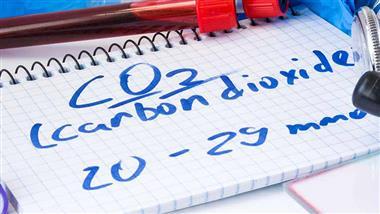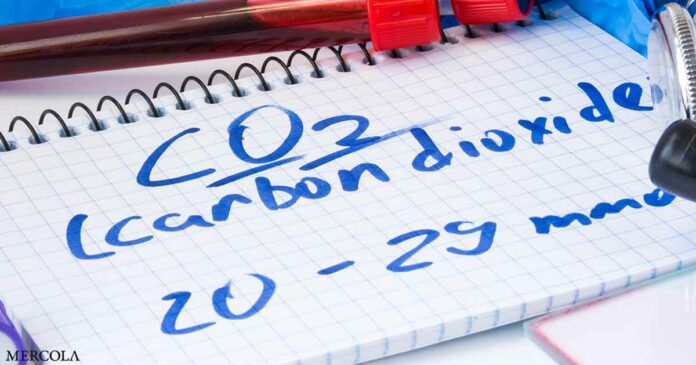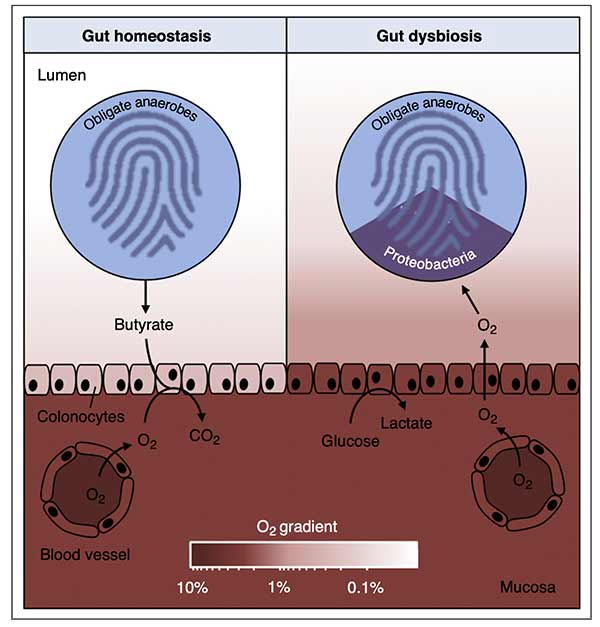
Story at-a-glance
- CO2 plays a critical role in oxygen transport within the body; higher CO2 levels enable hemoglobin to release more oxygen to cells, a process explained by the Bohr and Haldane effects
- CO2 supports vital physiological functions such as improving vasodilation, gut health, and the functionality of Vitamin K, which includes enhancing blood clotting and bone mineralization
- Proper carbohydrate oxidation produces 50% more CO2 compared to fat oxidation, enhancing the delivery of oxygen to cells and boosting energy production
- Increasing your CO2 levels can elevate your metabolic rate, as CO2 helps deliver oxygen more efficiently, allowing cells to produce significantly more energy from glucose
- Proper carbohydrate metabolism and controlled breathing (preferably nasal) will help you maintain optimal CO2 levels
Understanding the importance of CO2 to human physiology was one of the things that made me realize that being a good carb burner is necessary to achieve optimal health. CO2 is health supporting.
And the proper oxidation of carbohydrates produces 50% more carbon dioxide than fat oxidation (in other words, you produce 50% more CO2 when you properly burn carbs).
Many understand how important oxygen is — we have to breathe, right? Oxygen is vital for energy metabolism. It is the final electron acceptor in the electron transport chain. And when O2 isn’t available in the cell, our cells then use the inefficient glycolytic pathway (fermentation) for energy production more than necessary.
What is not commonly understood is HOW oxygen gets to our cells, and that process relies on CO2! CO2 is often labeled a “byproduct” of energy metabolism, but it is not given the credit it deserves. More CO2 means more oxygen is delivered to our cells, improving our energy production. It is a feedforward cycle since we are able to produce more energy and thus more CO2.
This is because the delivery of O2 requires an exchange of gases (CO2 and O2) at the cellular level. Hemoglobin, a protein in our blood responsible for carrying CO2 and oxygen, releases the oxygen bound to it in the presence of higher CO2 concentrations. And releases CO2 in the presence of higher O2 concentrations. The relationship between O2 and CO2 in the body is explained by the Bohr and Haldane effect:1
- Bohr — High concentration of CO2 in the cells causes a low pH (acidic environment), causing hemoglobin to unload more O2 in the cells and take up CO2
- Haldane — High concentration of O2 in the lungs means hemoglobin will unload CO2 and take up oxygen
The higher the concentration of CO2, the more effectively oxygen can be utilized and the better we will make energy. But improving oxygen delivery is just one benefit of CO2. Here are eight more.
Eight Benefits of CO2
1. CO2 increases the metabolic rate — Since CO2 promotes delivery of O to cells, we can produce more energy per molecule of glucose (~36 ATP relative to 2 ATP) using full oxidative phosphorylation (proper carb burning).
“The presence of carbon dioxide is an indicator of proper mitochondrial respiratory functioning.” ~ Ray Peat, Ph.D.
2. CO2 improves function of Vitamin K since CO2 concentrations determine the rate of Vit K dependent carboxylation reactions2 — CO2 activates the Vit K dependent proteins & thus assists fat soluble vitamins in fulfilling their physiological functions.
“The greater the supply of carbon dioxide, the better vitamin K can do its job.” ~ Chris Masterjohn, Ph.D.
“[V]itamin K uses [CO2] to activate proteins that protect our heart valves and blood vessels from calcification.” ~ Chris Masterjohn, Ph.D.
CO2 is thus important for the following Vit K functions: blood clotting, preventing soft tissue calcification, mineralizing bones and teeth, utilizing energy, and hormonal health.
3. CO2 improves vasodilation by relaxing smooth muscles around blood vessels3,4 — A vasodilator is a substance that causes smooth muscle to relax thus dilating the tubular passages it lines.
4. CO2 improves gut health — You want HIGH CO2 levels in your gut, and many people, unfortunately, have LOW CO2 levels and HIGH O2 levels (not what we want!)
The colonic microflora is extremely complex. And while it is near impossible to define what the ideal microbiome should look like (resident microbes are highly diverse, vary between individuals, and change with diet), recent evidence supports that colonic bacteria should be dominated by obligate anaerobic bacteria (meaning they cannot survive in high oxygen environments) that are able to benefit us by breaking down non-usable fibers.5
Balanced gut microbiomes are characterized by the dominance of obligate organisms, while an expansion of facultative organisms (bacteria that can survive in high O2 environments) is a common marker of gut dysbiosis.
Thus, the inside of the colon should be a low oxygen and high CO2 environment to ensure we have dominance of obligate anaerobes that can breakdown complex carbs and provide our cells with short chain fatty acids, and lower levels of facultative organisms since these facultative anaerobic bacteria do not specialize in consuming fiber and might even interfere with host nutrition.
So, maintaining a low oxygen and high CO2 environment helps keep the microbiome in check. The internal environment of our body impacts how our body functions.
5. CO2 improves calcium utilization6 — When CO2 exits the cell, it brings with it free water and calcium,7 lowering cellular bulk water. It is toxic to have persistent intracellular calcium, and you want as little free water as possible inside cells. In fact, some machines use the intracellular water level when looking for cancer.8
“The carbon dioxide can be changed into carbonic acid, by chemically combining with water. Carbonic acid is hydrophilic, and so it quickly leaves the cell, taking with it some of the oppositely charged ions, such as calcium and sodium.”9
6. CO2 protects the cell and mitochondria structure from damage, acting like an antioxidant and cell stabilizer — Since it improves oxygen delivery, it reduces free radical damage.10,11,12,13,14 It also protects against hypoxia and the negative effects of intracellular calcium and inflammation.15,16,17,18,19,20 Abundant CO2 inside and outside the cell protects lipids and proteins susceptible to oxidation.21,22 In fact, CO2 is part of our antioxidant defense system.23
“The suppression of mitochondrial respiration increases the production of toxic free radicals, and the decreased carbon dioxide makes the proteins more susceptible to attack by free radicals.” ~ Ray Peat, Ph.D.
“The failure to oxidize glucose to CO2 is oxidative stress.” ~ Ray Peat, Ph.D.
7. CO2 prevents accumulation of lactic acid in the cell, which we see in cancer, diabetes, and other chronic conditions24,25,26,27 — Lactic acid is a byproduct of inefficient carb metabolism that suppresses efficient oxidation of glucose and burdens the liver’s energy supply. Elevated lactic acid levels have a hypoxic effect and signals to the cell that it is under stress.
“The presence of lactic acid, which indicates stress or defective respiration, interferes with energy metabolism in ways that tend to be self-promoting. Harry Rubin’s experiments demonstrated that cells become cancerous before genetic changes appear. The mere presence of lactic acid can make cells more susceptible to the transformation into cancer cells. (Mothersill, et al., 1983.)
Diabetics typically have elevated lactate, which shows that glucose doesn’t have a problem getting into their cells, just getting oxidized.” ~ Ray Peat, Ph.D.
More CO2 improves oxidation and thus prevents accumulation of lactic acid since full oxidative phosphorylation (proper carb metabolism) can occur.
“Lactic acid and carbon dioxide have opposing effects.” ~ Ray Peat, Ph.D.
8. CO2 improves longevity — The higher you live in altitude (and thus the higher CO2 levels), the lower the cancer, heart disease and overall better health.28 Moreover, maximum lifespan of mammals is positively correlated with blood CO2.29
“People who live at very high altitudes live significantly longer; they have a lower incidence of cancer (Weinberg, et al., 1987) and heart disease (Mortimer, et al., 1977), and other degenerative conditions, than people who live near sea level.” ~ Ray Peat, Ph.D.
How Do We Achieve Higher CO2 Levels?
How we eat and breathe impacts how much CO2 we have in our body. You can increase the endogenous production (with proper carb burning), or reduce the outflow (with proper breathing).
CO2 is formed intracellularly during energy metabolism inside the mitochondria. Since carbs are richer in oxygen than fat, they consume less water in their metabolism and release 50% more CO230 (if we use them properly). The more carbs we efficiently burn for energy, the more CO2 we make.
“Higher CO2 has benefits, and a higher ratio of carbohydrates to fat being oxidized for fuel yields greater CO2.”31
The body’s primary source of CO2 is cellular metabolism — so properly burning carbs is the primary source of CO2. In fact, the Keto diet significantly reduces carbon dioxide stores.32 Even Dr. Lustig admits that ketosis reduces the amount of CO2 produced by the body in relation to the amount of oxygen it consumes.33
How we breathe also impacts the CO2 levels inside of our body, as we blow off a ton of CO2 with mouth breathing! Mouth breathing is, in a sense, self-suffocation and hyperventilation when taken to the extreme because we’re driving down CO2 levels to the point that we decrease oxygen availability to the cells. Overtime this can lead to degeneration, and a lot of mouth breathing is a sign of a stressed and lowered metabolism.
Nose breathing is a MUST, and utilizing mouth tape can help reduce levels of mouth breathing while sleeping. For extra CO2 work, try nose bag breathing with a brown paper bag to increase CO2 levels. This is very powerful to do before bed!
In summary, there are a number of health advantages of having elevated cellular CO2 levels. Proper breathing is very important for blood CO2 levels, but it does not change cellular CO2 levels — what you eat does! And being a good carb burner is one of the best ways to achieve elevated levels.
Transform Your Health — One Step at a Time


Ashley and her sister Sarah have put together a truly groundbreaking step-by-step course called “Rooted in Resilience.” They have compiled what clearly is the best application of Dr. Ray Peat’s work on Bioenergetic Medicine that I have ever seen.
It is so good that I am using the core of their program to teach the many Health Coaches that I am in the process of training for the new Mercola Health Clinics I am opening this fall. It took these women working nearly full-time on this project for a year to create it.
This has to be one of the absolute best values for health education I have ever seen. If you want to understand why you struggle with health problems and then have a clear program on how to reverse those challenges, then this is the course for you.
It is precisely the type of program I wish I would have had access to when I got out of medical school. I fumbled around for decades before I reached the conclusion they discuss in the course and share with you so you can restore your cellular energy production and recover your health.
|
Select and eat the right foods to heal your metabolism and improve glucose utilization |
|
Balance your hormones to help reduce anxiety, weight gain and sleep disturbances |
|
Use reverse dieting to increase your calories without gaining weight and tanking your metabolism, all while improving your energy levels |
|
Heal your gut for proper immune function, mood and weight management |
|
Tweak your diet and lifestyle habits to improve your mindset and mental health |
|
Crush your fitness goals with ease and get your life back on track |
|
Master the most essential habits for health with bonus guides, including over 100 meal plans to take the stress out of meal time planning and shopping, and so much more! |
Learn more about Rooted in Resilience here.


About the Author
Ashley Armstrong is the cofounder of Angel Acres Egg Co., which specializes in low-PUFA (polyunsaturated fat) eggs that are shipped to all 50 states (join waitlist here), and Nourish Cooperative, which ships low-PUFA pork, beef, cheese, A2 dairy and traditional sourdough to all 50 states. Waitlists will reopen shortly.
- 1 Jpn J Physiol 1984;34(2):205-16
- 2 J Biol Chem 2011 Dec 30;286(52):44821-32
- 3 Stroke 1977;8:226–229
- 4 J Thorac Cardiovasc Surg. 2004 Sep;128(3):354-6
- 5 Nat Rev Microbiol 2018 Feb;16(2):103-110
- 6 Aviat Space Environ Med 1998 Mar;69(3):291-8
- 7 Pflugers Arch 2010 Nov;460(6):953-64
- 8 Structural Dynamics 7, 054701 (2020)
- 9 Ray Peat Water: swelling, tension, pain, fatigue, aging
- 10 Physiol Res 2002;51(4):335-9
- 11 Vopr Med Khim 1996 Jul-Sep;42(3):193-202
- 12 Izv Akad Nauk Ser Biol 1997 Mar-Apr:(2):204-17
- 13 Patol Fiziol Eksp Ter 1995 Jul-Sep:(3):34-40
- 14, 22 Vojnosanit Pregl 1996 Jul-Aug;53(4):261-74
- 15 Fiziol Zh SSSR Im I M Sechenova 1978 Oct;64(10):1456-62
- 16, 21, 23 Fiziol Zh Im I M Sechenova 1995 Feb;81(2):47-52
- 17 Stroke 1996;27:1634–1640
- 18 Acta Neurobiol Exp 2007;67(2):197-206
- 19 Biull Eksp Biol Med 1994 Oct;118(10):395-8
- 20 Biull Eksp Biol Med 1995 Jun;119(6):590-3
- 24 Clin Endocrinol 2011 Feb;74(2):191-6
- 25 Int J Epidemiol 2010 Dec;39(6):1647-55
- 26 Diabetes 1988;37(8):1020–1024
- 27 Ray Peat Lactate vs. CO2 in wounds, sickness, and aging; the other approach to cancer
- 28 Aging Dis 2014 Aug; 5(4): 274–280
- 29 Biogerontology 2013; 14: 687-691
- 30 ChrisMasterjohnphd.com
- 31 Journal of Evolution and Health An Ancestral Health Society Publication March 2017; 2(1)
- 32 Lung 2015 Dec;193(6):939-45
- 33 Harvard TH Chan Keto diet considered for Navy SEALS
Source: Source link
Publish Date: 4/23/2024 12:00:00 AM


